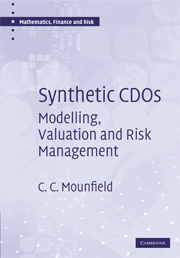Book contents
- Frontmatter
- Contents
- Preface
- Acknowledgements
- 1 A primer on collateralised debt obligations
- 2 Modelling of obligor default
- 3 Valuation of credit default swaps
- 4 Credit indices
- 5 Valuation of default baskets
- 6 Valuation of synthetic CDOs
- 7 Phenomenology of the standard market model
- 8 Risk quantification of synthetic CDOs
- 9 Implied and base correlations
- 10 Extensions of the standard market model
- 11 Exotic CDOs
- 12 Correlation trading of synthetic CDO tranches
- 13 Risk management of a portfolio of synthetic CDOs
- 14 Hedging simulation of structured credit products
- Appendix A Explanation of common notation
- Appendix B Simulated annealing
- References
- Index
Appendix B - Simulated annealing
Published online by Cambridge University Press: 06 July 2010
- Frontmatter
- Contents
- Preface
- Acknowledgements
- 1 A primer on collateralised debt obligations
- 2 Modelling of obligor default
- 3 Valuation of credit default swaps
- 4 Credit indices
- 5 Valuation of default baskets
- 6 Valuation of synthetic CDOs
- 7 Phenomenology of the standard market model
- 8 Risk quantification of synthetic CDOs
- 9 Implied and base correlations
- 10 Extensions of the standard market model
- 11 Exotic CDOs
- 12 Correlation trading of synthetic CDO tranches
- 13 Risk management of a portfolio of synthetic CDOs
- 14 Hedging simulation of structured credit products
- Appendix A Explanation of common notation
- Appendix B Simulated annealing
- References
- Index
Summary
In the text several references are made to the technique of simulated annealing for the purpose of finding optimal solutions to a particular multivariate problem. Here we provide an introduction to this technique and describe why it is such a powerful and intuitively appealing tool for a wide range of problems.
Consider that we have an instrument whose value is a function of a set of variables {si}. Denote this by V({si}). In the context of synthetic CDOs the variables {si} could correspond to the spreads of the underlying obligors, for example. Our objective could be to determine the optimal composition of the underlying pool (choosing, for example, 100 obligors from the overall universe of obligors) such that we obtain the maximal par spread of the tranche while stipulating that the weighted average spread of the underlying pool is a minimum, i.e. maximising the carry (return) for minimal risk.
To visualise the problem it is helpful to think of the independent variables {si} as defining a multi-dimensional parameter space. Each choice of a set of values for the variables defines a point in the space (a particular point in parameter space will be referred to as a ‘configuration’ of the system, adopting the language of statistical mechanics). The objective of the optimisation is to find the point(s) in the parameter space that meet the specified objectives, while at the same time satisfying any constraints that are imposed on the solution (e.g. the pool weighted average spread cannot exceed 100 bps).
- Type
- Chapter
- Information
- Synthetic CDOsModelling, Valuation and Risk Management, pp. 352 - 356Publisher: Cambridge University PressPrint publication year: 2008



